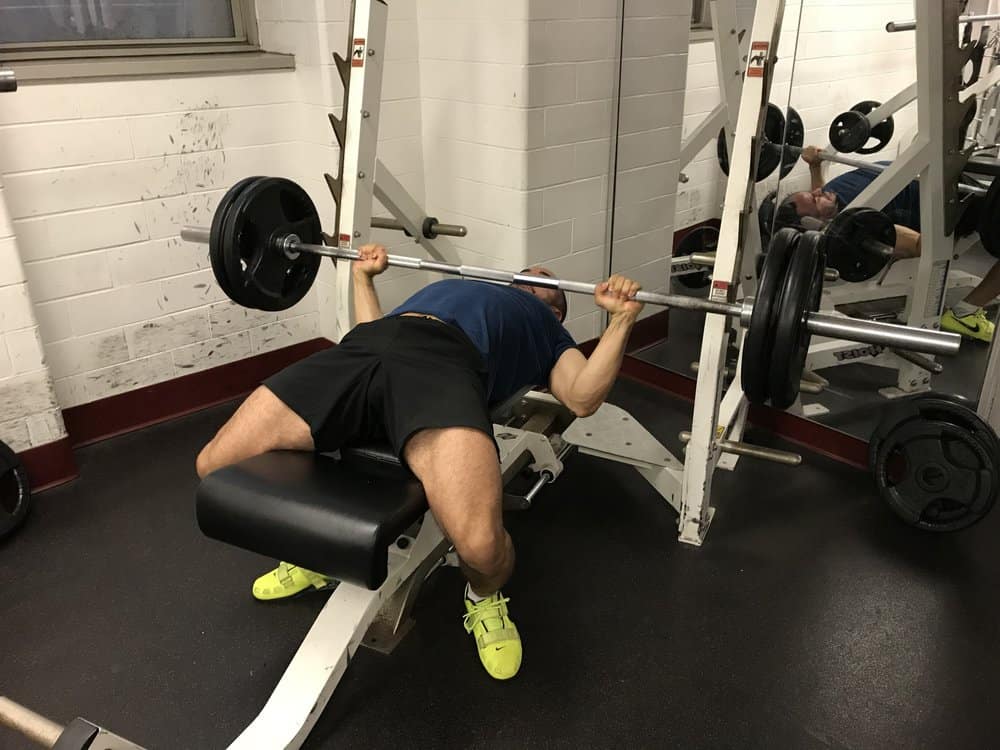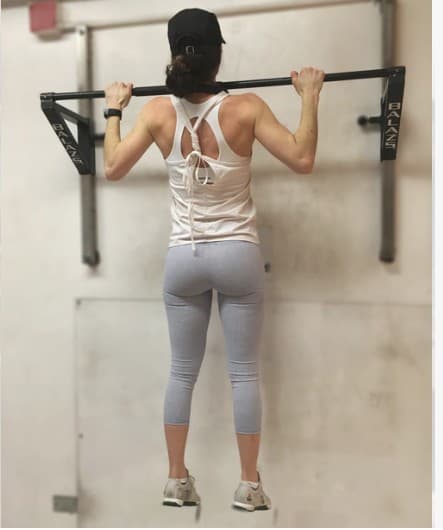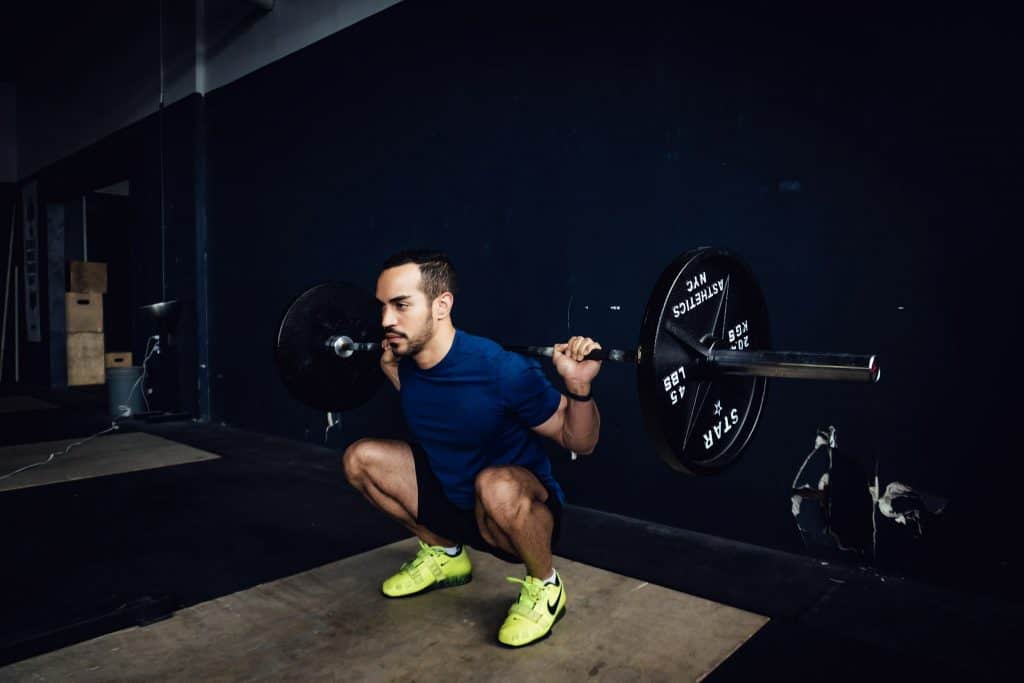In today’s post, you are going to learn everything you need to know about the push pull legs split.
Specifically, you’ll learn:
- What the push pull leg split is, and who should use it,
- The best exercises to include in this type of training program,
- and how to design a workout using this routine (for at home or gym workouts)
Let’s dive right in.

What is the Push Pull Legs Split?
The push pull legs split is a type of training program that is divided into three distinct workouts.
There is a push workout, a pull workout, and a legs workout.
Each workout focuses on developing different muscle groups based on their action. The first two focus on the upper body, while the third workout focuses on the lower body.
Why The Push Pull Legs Split Works
Your body produces movement via two types of muscular mechanisms: agonists and antagonists. The agonists are the muscles that make a specific movement happen. The antagonists are the muscles that oppose the action of the agonists.
Naturally, when the agonist is active and contracting, the antagonist is relaxed. The concept of push pull legs workout uses this phenomenon for the push and pull workouts.
Put simply, when you are pushing, the pulling muscles are relaxed.
When you are pulling, your pushing muscles are relaxed. This way, you can be sure that you are training in a balanced and well-rounded way for your upper body.
As for the legs, I will show you how to do something similar by breaking up the leg workout into two different segments.
But before we do that, let’s go over the exact muscles you will train in each exercise.
What Are The “Push” Muscles?
Generally, a push pull legs workout consists of three distinct workouts. Each workout targets three different groups of muscles in your body.
The first is the push movements.
The pushing muscles include your shoulders, your triceps, and your chest muscles. There are several different types of exercises that focus on these muscle groups. Common examples include:
Horizontal Pushing Exercises:
- Incline dumbbell bench press
- Flat dumbbell bench press
- Incline barbell bench press
- Flat barbell bench press
- Close-grip barbell bench press

Vertical Pushing Exercises:
And Isolation Pushing Exercises:
- Flat dumbbell chest flys
- Dumbbell pullovers
- Tricep Pushdowns
- Skull crushers
- Overhead DB tricep extensions
As you can see there are many exercises to choose from.
The good thing is that you can rotate and switch the exercises every 12 weeks or so to keep things interesting.
In general, you should select at least 1 horizontal and 1 vertical pushing exercise, while adding isolation movements as needed.
What Are The “Pull” Muscles?
The pulling muscles of your upper body include your back (rhomboids, trapezius, latissimus dorsi, posterior shoulders) and your biceps.
Just like the push, these exercises can be divided into horizontal and vertical pulling.
Vertical Pulling Exercises:
Horizontal Pulling Exercises:

Isolation Pulling Exercises
Like the push muscles exercises, it would be ideal to include at least 1 horizontal and 1 vertical pull in your routine. Isolation work can be added as needed.
What Are The “Leg” Muscles?
Lastly, we get to the leg exercises in the push pull leg routine.
These muscles include quads, hamstrings, glutes, and calves. You can add one or two of the following exercises for each muscle group.
These exercises can be broken down into knee dominant exercises and hip dominant exercises.
Hip Dominant Leg Exercises:
Knee Dominant Leg Exercises:

Isolation Leg Exercises:
- Leg curls
- Leg extensions
- Calf raises
As before, do your best to include 1-2 exercises from each of the first two categories. Isolation exercises can be added in as needed.
You can see a complete list of all the best compound exercises here.
The Push Pull Legs Schedule
So now that you know what the PPL split is, let’s go over how to schedule it.
The first question is, how often should you train on a weekly basis?
Three days vs six days
In general, there are two types of push pull legs schedule: one that is three days and the other is six days.
The primary benefit of going for a 3-days split is that there is always a rest day after each workout.
That way, you get more time to recover from your workout. Also, this type of routine is easy to implement into a busy work schedule.
In contrast, working out six days a week will get you quicker results. Since you’re working out more frequently, you are essentially doubling the stimulus your muscles get on a weekly basis.
However, this routine is quite demanding for a beginner, I do not recommend it.
I go over this in more detail in: How Many Times Should You Workout In A Week?
Is Push Pull legs once a week enough?
Yes, doing one push, one pull, and one leg workout per week is enough to see results.
In fact, I often recommend three to four days as the optimal frequency to build muscle and gain strength.
Results may be slower, but working out three times per week is healthy and feasible for most people.
Is Push Pull legs twice a week too much?
It depends on what strength level you are at. For beginners, PPL twice a week can be too much and can even lead to injury.
However, intermediate or advanced lifters can see benefits in the twice per week (6-day) routine. In fact, research shows that twice per week training can be more beneficial than once per week in terms of muscle growth.
The important thing is that you don’t overexert yourself and you are recovering properly between workouts.
A Sample Push Pull Legs Workout Routine (3 Day Split & 6 Day Split)
Below are two sample push pull legs workout schedules for beginner/intermediate lifters, and advanced lifters respectively.
For the beginner program, you should perform the following routine on alternate days in the following pattern:
- Push Day
- Rest
- Pull Day
- Rest
- Legs Day
- Rest
- Rest
The advanced lifter workout should look like this:
- Push Day
- Pull Day
- Legs Day
- Rest
- Push Day
- Pull Day
- Legs Day
- Rest
The Push workout:
The push workout will target the triceps, the shoulders, and the chest muscles. Here is a good example:
| Exercise | Sets | Reps |
|---|---|---|
| Barbell Bench Press | 3 | 6-8 |
| Shoulder Press | 3 | 6-8 |
| Dumbbell Chest Flys (superset A) | 3 | 10-12 |
| Overhead DB Tricep Extensions (superset B) | 3 | 10-12 |
Remember that these exercises are only a few of the various exercises you can use to create one or two push workouts.
The Pull Workout:
The pull workout will target your biceps, posterior shoulders, and back muscles. Here is a good example:
| Exercise | Sets | Reps |
|---|---|---|
| Barbell Row | 3 | 6-8 |
| Pull-ups | 3 | 6-8 |
| Rear Delt Flys (superset A) | 3 | 10 |
| Face Pulls (superset B) | 3 | 10 |
Again, you can use this template as a baseline to help you mix and match the exercises that suit your skill level.
The Legs Workout:
The leg workout will target your glutes, hamstrings, and quads. Here is a good example:
| Exercise | Sets | Reps |
|---|---|---|
| Front Squat | 3 | 6-8 |
| Romanian Deadlift | 3 | 6-8 |
| Reverse Lunge (superset A) | 3 | 10 |
| Core Exercise of your choice (superset B) | 3 | 10 |
As you can see, we have included a slot for core exercises. Core training is beyond the scope of this article, but you can learn all about the proper way to train your core in my post The 17 Best Core Exercises For Strength.
If you want, you can create two separate push workouts, two separate pull workouts, and two separate leg workouts to alternate through.
So if you are doing a 3x per week training program, you can do Push A, Pull A, Legs A on Week 1, then Push B, Pull B, and Legs B on Week 2.
Alternatively, you can do all 6 workouts in the same week if you are using the 6x per week training program.
Can I Do Push Pull Legs with a 4 or 5 Day Split?
The push pull leg split can be done with a 4 or 5-day routine.
The only thing is, each week will be slightly different as there is no way to balance out 3 distinct workouts in a 4 to 5 day week.
For example, a four day week using PPL might look like this:
Push Pull Legs 4 Day Split Week 1
- Push Day
- Pull Day
- Off
- Leg Day
- Push Day
- Off
- Off
Push Pull Legs 4 Day Split Week 2
- Pull Day
- Leg Day
- Off
- Push Day
- Pull Day
- Off
- Off
And then a sample 5 day routine might look something like this:
Push Pull Legs 5 Day Split Week 1
- Push Day
- Pull Day
- Legs Day
- Off
- Push Day
- Pull Day
- Off
Push Pull Legs 5 Day Split Week 2
- Leg Day
- Push Day
- Pull Day
- Off
- Leg Day
- Push Day
- Off
As you can see, this workout schedule can get quite complicated. It could be done, but I think it’s much easier to just do a 3 day work week (If you are a beginner or early intermediate) or a 6 day work week (if you are more of an advanced lifter).
A Sample Push Pull Legs Routine At Home
What about home workouts? Can you do a PPL routine at home with no weights?
Absolutely!
All you have to do is design each workout around the basic calisthenic exercises.
The Calisthenics Push Exercises
The Calisthenics Pull Exercises
The Calisthenics Leg Exercises
Although your exercise selection may seem limited at first, the beauty of calisthenics is that each one of these exercises has dozens of variations to choose from.
That way, you can always keep progressing and finding a variation that will challenge your skill level.
So here is how the workout might look like.
The At-Home Push Pull Legs workout:
The Push Workout
| Exercise | Sets | Reps |
|---|---|---|
| Incline Push-ups | 3 | 8-12 |
| Pike Push-ups | 3 | 8-12 |
| Dips | 3 | 8-12 |
| Handstand practice | 3 |
The Pull Workout:
| Exercise | Sets | Reps |
|---|---|---|
| Pull-ups | 3 | 8 |
| Inverted Rows | 3 | 8-10 |
| Front Lever Raises | 3 | 5 |
| Core Exercise | 3 | 10 |
The Legs Workout:
| Exercise | Sets | Reps |
|---|---|---|
| Bodyweight Squats | 3 | 10-12 |
| Glute Bridge | 3 | 10-12 |
| Step-ups | 3 | 8 |
| Core Exercise | 3 | 10 |
Other Related Questions
Is Push Pull Legs a bro split?
Some people refer to PPL splits as “bro splits.” They are also sometimes even referred to as “triple splits” because a Push Pull Leg split consists of isolating three separate body parts.
However, I don’t consider it to be a true bro split as the original bro split isolates individual muscles in each workout.
For example,
- Monday: Chest Day
- Tuesday: Back Day
- Wednesday: Shoulder Day
- Thursday: Biceps and Triceps Day
- Friday: Quads
These kinds of splits are not an efficient use of time as I discuss in the three best workout splits of all time.
Is push pull legs good for building muscle?
The push pull leg split is a great routine for building muscle.
That’s because muscle growth requires two things: resistance, aka loading, and rest.
A push pull leg workout will strategically provide each of the major muscle groups in your body with appropriate resistance and adequate time to rest and recover. I go over more details in How to Build Muscle Naturally Using Science.
Is it the best? That’s up to you to decide.
The best routine will always be the one you can stick to long-term.
Is push pull legs good for fat loss?
The push pull legs split can be an effective training split for fat loss if you couple it with dietary changes. Your diet will always be more important than your training.
With that said, the best way to use this split for fat loss is to use a high training volume. In other words
- use lighter weight
- use a high rep range (10+ reps per set)
- do more training days (4,5, or 6)
What are the main benefits of push pull leg split?
Besides being a highly effective workout split for building muscle, the push pull leg routine has several other advantages.
These benefits include the following:
Simplicity
Many workout programs can be complicated and overwhelming. Especially if you are a beginner and don’t know how to get started. The push pull legs split is easy to follow, and simple to understand.
You can only train one major movement pattern per workout. It doesn’t get simpler than that.
It minimizes exercise overlap
Since the entire concept of a push pull leg routine is to mix and match movement patterns – you will never be working the same muscle groups on consecutive days.
Each workout has a dedicated purpose, ensuring that you do not overtrain any specific muscle or movement pattern. Plus, you can always use different exercises every 12 weeks or so to ensure your training is well-rounded.
It balances your training
Another important thing to consider is that you likely have muscular imbalances.
This is because most people push much more than they pull. The PPL workout split ensures that you train each body part evenly, helping to iron out any imbalances you may have.
Final Words On The Push Pull Legs Routine
The PPL split has gained a lot of popularity lately due to its simplicity and effectiveness in balancing your training.
It is one of the best ways to build muscle and gain strength, without complicating your workout routine. With that said, it works best with a 3x per week training frequency, or a 6x per week frequency if you are more experienced.
Okay, so now it’s time for you to get to work.
Which PPL template are you going to use first?
Comment below and let me know.
Related Posts On Split Workout Training
- The Full Body Workout Split [Template Included]
- The Upper/Lower Split [Gym and At Home Workouts Included]
- How To Workout Effectively [Even If You Don’t Know Where To Start]

Alex Robles, MD, CPT / Brittany Robles, MD, MPH, CPT
Alex & Brittany Robles are physicians, NASM Certified Personal Trainers, and founders of The White Coat Trainer: a resource dedicated to improving the health and fitness of busy professionals using time-efficient strategies. Their advice has been featured in My Fitness Pal, Prevention, Livestrong, Reader’s Digest, Bustle, The Active Times, and more. Learn more about them here.
